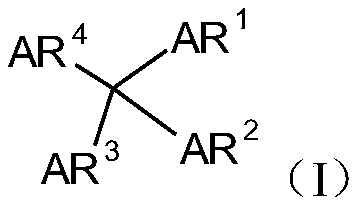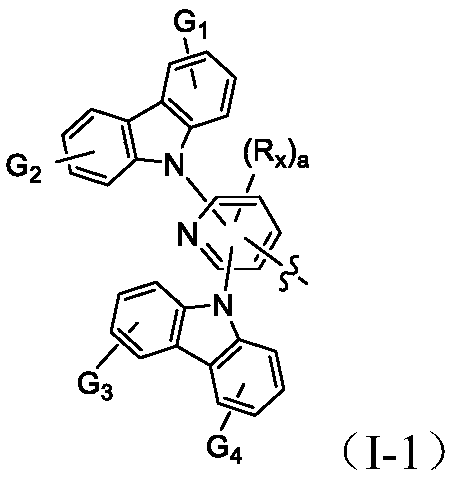Carbazole pyridine compound and applications thereof
A technology of carbazolpyridine and compounds, which is applied in the field of organic electroluminescent materials, can solve the problems of low triplet energy level, poor thermal stability, and insufficient glass transition temperature, and achieve long device life and good luminescent performance.
- Summary
- Abstract
- Description
- Claims
- Application Information
AI Technical Summary
Problems solved by technology
Method used
Image
Examples
Embodiment 1
[0085] Embodiment 1: the synthesis of compound (A-4)
[0086]
[0087] 2,6-Dibromo-pyridine (2.35g, 10mmol) and carbazole (3.7g, 22mmol) were added to a round bottom flask, then 0.5g of cuprous iodide, 0.5g of cyclohexanediamine, anhydrous phosphoric acid Potassium 8.3g, toluene 200mL, after evacuating nitrogen, heat up to 110 degrees, react for 24 hours, cool to room temperature, add 100mL water, dichloromethane separate liquid extraction three times, combine the organic phase, concentrate the organic phase after drying, and mix with silica gel Sample through the column. 2.9 g of solid intermediate (M-1) were obtained.
[0088]
[0089] Add intermediate (M-1) (0.41g, 1mmol), acetone (0.03g, 0.5mmol), hydrogen fluoride (0.2g 10mmol) into the sealed tube, replace the air in the glove box, heat to 130 degrees, and react for 24 hours , after cooling, the mixture was added to water, separated and extracted three times with dichloromethane, the organic phases were combined,...
Embodiment 2
[0091] Embodiment 2: the synthesis of compound (A-5)
[0092]
[0093] Add 2,6-dibromo-4-fluoro-pyridine (2.53g, 10mmol) and carbazole (3.7g, 22mmol) into a round bottom flask, then add 0.5g of cuprous iodide and 0.5g of cyclohexanediamine , anhydrous potassium phosphate 8.3g, toluene 200mL, after evacuating nitrogen, heat up to 110 degrees, react for 24 hours, cool to room temperature, add 100mL of water, separate liquid extraction with dichloromethane three times, combine organic phases, dry and concentrate organic phase, the silica gel was mixed and the sample was passed through the column. 2.7 g of solid intermediate (M-2) was obtained.
[0094]
[0095] Add diphenylmethane (0.34g, 2mmol) into 10mL of anhydrous tetrahydrofuran, and add dropwise into the tetrahydrofuran dispersion of sodium hydride (0.24g of sodium hydride, 10mL of tetrahydrofuran) at zero temperature, and stir for 1 hour after the dropwise addition is completed. The tetrahydrofuran solution (M-2, 0...
Embodiment 3
[0099] Embodiment 3: the synthesis of compound (A-6)
[0100]
[0101] The synthesis method is similar to that of Example 2, except that diphenylmethane is replaced by di-p-tolylmethane.
[0102] 1 H NMR (400MHz, Solvent: CDCl3) δppm: 8.12(8H), 7.85(8H), 7.45(8H), 7.35(18H), 7.13(8H), 7.06(4H), 2.30(6H).
PUM
 Login to View More
Login to View More Abstract
Description
Claims
Application Information
 Login to View More
Login to View More - R&D
- Intellectual Property
- Life Sciences
- Materials
- Tech Scout
- Unparalleled Data Quality
- Higher Quality Content
- 60% Fewer Hallucinations
Browse by: Latest US Patents, China's latest patents, Technical Efficacy Thesaurus, Application Domain, Technology Topic, Popular Technical Reports.
© 2025 PatSnap. All rights reserved.Legal|Privacy policy|Modern Slavery Act Transparency Statement|Sitemap|About US| Contact US: help@patsnap.com



